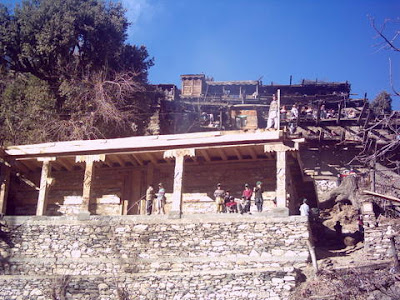
It is as difficult to measure Rangeela's influence, as it is to count his hyphens.
This body-builder- painter- actor- hero- comedian- producer- director- writer- singer- distributor- composer also happens to be the great communicator.
He moved to Lahore at a young age and earned his livelihood by painting billboards for the Lahore movie industry. But soon he realized that following the humble career of bill-board painter would not sustain his talents. Therefore, he struggled to get an appearance on the big screen. His movie career started back in the late 1950s and his efforts got fruitful results when he made his professional cinematic debut in a 1958 Punjabi film called ‘Jatti’, directed by M.J. Rana. While Aik Aur Love Story produced in 1999 was his last film. He appeared as hero in box-office hits like Do Rangeelay.

He produced and directed his first film ‘Diya aur Toofan’ in 1969 in which Ijaz and Firdous played the lead roles. He also shone as a singer and his ‘Ga Mairay Manwa Gata Ja Re’ considered as all-time hit song. He directed numerous movies under the banner of Rangeela Productions. Excellence of his acting potential was enormous in the super hit film ‘Rangeela’, released on September 11, 1970; in which he played the title role of Rangeela. He possessed that un-expressible pathos in his voice that brought tears into the eyes of the listeners. His forte was tragic songs, and he was proficient at slow numbers. Rangeela earned plaudits for his third consecutive super hit film 'Dil Aur Duniya', October 1, 1971, starring Habib-Aasia-Rangeela. The above three films were big hits at the box office enabling Saeed Khan Rangeela to complete his celluloid 'hat trick'.

Rangeela, the Comedy King, bagged numerous awards in his life which included nine Nigar Awards. Nigar Award for Best screen-writer in the film Rangeela in 1970, best comedian in the film Dil Aur Duniya in 1971.Nigar Award for simultaneously playing three roles in the film Meri Zindigi Hai Naghma in 1972.
Complete List of Awards Won During The Career
* Nigar Award for best screen- writer, in the film 'Rangeela' in 1970.
* Nigar Award for best comedian, in the film 'Dil Aur Duniya' in 1971.
* Nigar Award for simultaneously playing three roles in the film 'Meri zindigi hai naghma' in 1972.
* Nigar Award for best comedian in the film 'Naukar tay malik' in 1982.
* Nigar Award for best story- writer, in the film 'Sona chandi' in 1983.
* Nigar Award for best director in the film 'Sona chandi' in 1983.
* Nigar Award for best comedian in the film 'Miss Colombo' in 1984.
* Nigar Award for best comedian in the film 'Baaghi qaidi' in 1986.
* Nigar Award for best comedian in the film 'Teen yakkay teen chakkay' in 1991.
Career As an Actor
* Hero (1992/II)
* International Gorillay (1990)
* Aurat Raj(1979)
* Do Tasweerain (1974)
* Kubra Ashiq (1973)
* Dosti (1971)
* Dil Aur Duniya (1971)
* Rangeela (1970)
* Diya Aur Toofan (1969)
* Gehra Daagh (1964)
* Bazar-e-Husn. 1988.
* Double version film 'Madam Bowery 1989.
* Double version film 'Rangeelay Jasoos. 1989.
* Double version film 'International Gorillay. 1990.
* The film 'Majhu platinum jubilee, 1991.
* Double version film 'Abdullah the great. 1992.
Career As a Director
* Aurat Raj (1979)
* Kubra Ashiq (1973)
* Dil Aur Duniya (1971)
* Rangeela (1970)
* Diya Aur Toofan (1969)
* Meri mohabbat teray hawalay.
* Subha ka tara
* Ganwaar
* Jahaiz.
* Namak halal.
* Ka ka jee.
* Raja Rani.
* Sahab Bahadur.
* Quli.
Career As a Producer
* Aurat Raj (1979)
* Kubra Ashiq (1973)
* Dil Aur Duniya (1971)
* Rangeela (1970)
* Diya Aur Toofan (1969)
Career As a Playback Singer
* Aurat Raj (1979)
* Do Rangeeley (1985)
Career As a Writer
* Rangeela (1970)


















